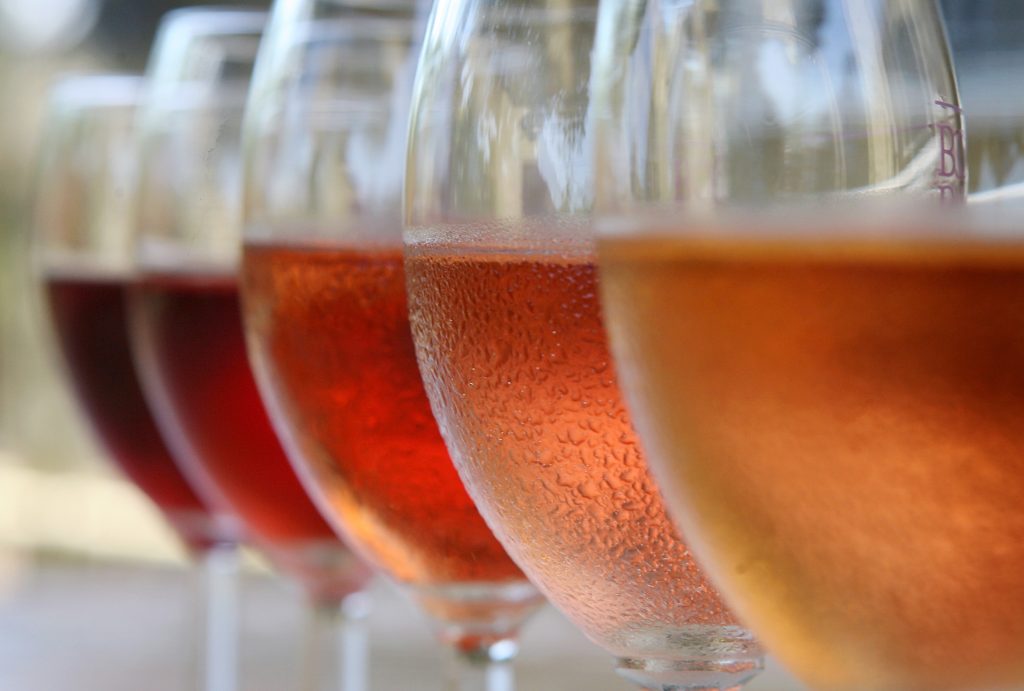
#357 – June 11, 2018
With a great slate of white wine options, it’s time to address the quintessential “summer wine” – rosé. With warmer weather being dragged kicking and screaming into June, the crescendo of need for good looking and refreshing thirst-quenchers is peaking and help is finally here. New York may have been deprived of any real semblance of spring this year but summer is coming and with wine the best way to combat summer’s discomfort, rosé is the poster-child of vinous relief. Representing a complete sensory attack of pleasure, beginning with its pastel coloring onto a palate of tart berry fruit and refreshing acidity along with low alcohol content and extreme food versatility, rosé is the perfect wine (although, as you all know by now, these characteristics dictate its everyday use throughout the entire year as well).
State of the Market
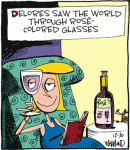 Before we get into what exactly rosé is all about, there are a few important comments about the general state of rosé in the kosher wine market that should directly influence your buying habits this season. While a step or two behind the general wine world’s current trends, rose’s exploding popularity continues seemingly unabated. After a nearly 50% increase in the number of rosé wines I tasted for last year’s newsletter, this year saw a further increase of over 20% as I doggedly tracked down and tasted 93 different rosé wines from around the world (even so, a few eluded me). An abundance of choices is usually good for the consumer, not only due because it caters to an increasingly growing number of palate preferences but also usually leads to a decrease in prices. However, in our case, rosé’s popularity has encouraged every winery to get in the game, regardless of whether raw materials (grapes), knowledge or experience are sufficiently present. Additionally (and beyond the simple havoc being wreaked on the consumer’s decision making process), surging demands has enabled wineries to partake in such extreme levels of chutzpadik pricing as to simply boggle the mind (first time Israeli rosé producer charging $40 – I’m talking to you).
Before we get into what exactly rosé is all about, there are a few important comments about the general state of rosé in the kosher wine market that should directly influence your buying habits this season. While a step or two behind the general wine world’s current trends, rose’s exploding popularity continues seemingly unabated. After a nearly 50% increase in the number of rosé wines I tasted for last year’s newsletter, this year saw a further increase of over 20% as I doggedly tracked down and tasted 93 different rosé wines from around the world (even so, a few eluded me). An abundance of choices is usually good for the consumer, not only due because it caters to an increasingly growing number of palate preferences but also usually leads to a decrease in prices. However, in our case, rosé’s popularity has encouraged every winery to get in the game, regardless of whether raw materials (grapes), knowledge or experience are sufficiently present. Additionally (and beyond the simple havoc being wreaked on the consumer’s decision making process), surging demands has enabled wineries to partake in such extreme levels of chutzpadik pricing as to simply boggle the mind (first time Israeli rosé producer charging $40 – I’m talking to you).
Off the Reservation
In addition to a further dip in overall quality from last year, I found a huge swath of options to be so lacking in fruit or body as to nearly resemble water. As a thirst-quencher, rose should enable more copious consumption than other wines by providing lighter bodied and lower alcohol than its peers but it still needs to have that summer quality brought on by red summer fruits and citrus. After years of calling out winemakers for their heavy-handed rosé wines, I am happy so many answered the call by harvesting early, avoiding Saignée (see below) and lowering alcohol; but they have gone a step or three too far and eliminated much of the exuberant freshness a rosé needs to retain (it would also behoove wineries to avoid the prior pitfall that befell so many (primarily Israeli) wineries making dessert wines; namely that rosé shouldn’t be viewed as an easy way to offload subpar grapes without harming the brand given the inability of most consumers to tell the difference). I remain optimistic they will reach nirvana by following the Ramban’s path for reaching the golden path, and this hard veer right is simply one step closer towards “middle ground”.
Mature = Evil
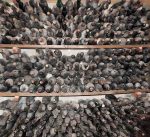 Further complicating issues is the amount of 2016 vintage rosé being pushed on unsuspecting consumers. Notwithstanding the success of Maria Jose Lopez in creating ageable rosé for Lopez de Heredia, the vast majority (and every single kosher option) are meant to be consumed during the year in the wine is released. As such, avoid any non-2017 vintage rosé and I’d seriously question any retailer attempting to sell you rosé from 2016 or earlier. Until consumers push back on the egregious method of making us pay for unsold wine (other than through properly disclosed discount-bin type sales), we will continue to be taken advantage of). Given the time lag created by export logistics, many rosé wines aren’t exported out of their producing country leaving each of Israel, California and France with a fair number of options only available in their respective countries of origin (noted as applicable below and whose difficulty in sourcing was the main reason for the delay of this year’s newsletter).
Further complicating issues is the amount of 2016 vintage rosé being pushed on unsuspecting consumers. Notwithstanding the success of Maria Jose Lopez in creating ageable rosé for Lopez de Heredia, the vast majority (and every single kosher option) are meant to be consumed during the year in the wine is released. As such, avoid any non-2017 vintage rosé and I’d seriously question any retailer attempting to sell you rosé from 2016 or earlier. Until consumers push back on the egregious method of making us pay for unsold wine (other than through properly disclosed discount-bin type sales), we will continue to be taken advantage of). Given the time lag created by export logistics, many rosé wines aren’t exported out of their producing country leaving each of Israel, California and France with a fair number of options only available in their respective countries of origin (noted as applicable below and whose difficulty in sourcing was the main reason for the delay of this year’s newsletter).
Too Many Options
 I usually try to get my newsletter on summer’s wine out the door before the season officially opens on America’s Memorial Day. However (and similar to last year’s predicament), the monumental number of available wines and their widely disparate geographic distribution ensured that completing the arduous task of tasting them all took longer than expected (I would be remiss if I didn’t publicly thank all my generous mules- tremendously appreciated). Rosé’s surging popularity has helped breach the formerly impregnable walls of even the most stubborn “red wine only” proponents who have reluctantly incorporated rosé into their summer repertoire. In order to service this growing market, producers are investing more time, effort and money in crafting higher quality rosé wines (with mixed results). Some of these efforts include designating specific plots specifically for rosé production (instead of simply using excess or lesser grapes) and earlier harvesting to ensure lower residual sugar and higher acidity. While the resulting corresponding increase in pricing was to be expected, it’s nonetheless unfortunate that the average price of the ultimate summer quaffer has climbed to a range of $25-$35 for most quality options (with many lacking the basic “quality” characteristic), which is an unacceptable price range. Given the lack of depth and sophistication and general “quencher” aspect of these wines, anything over $25 (more appropriately $20) is simply criminal. As a point of comparison, there are abundant non-kosher rosé options under $10, many of which are the qualitative equals of the higher-end kosher options whose average price is now north of $30. While I appreciate the commercial validity of giving consumers the options they seek, in the case of wineries producing a higher-end rosé in addition to their regular option (e.g. Château Roubine, Dalton La Citadelle de Diamant, Netofa, Recanati and Tabor), I find it defeats the purpose and almost always fails to meet the stated expectations.
I usually try to get my newsletter on summer’s wine out the door before the season officially opens on America’s Memorial Day. However (and similar to last year’s predicament), the monumental number of available wines and their widely disparate geographic distribution ensured that completing the arduous task of tasting them all took longer than expected (I would be remiss if I didn’t publicly thank all my generous mules- tremendously appreciated). Rosé’s surging popularity has helped breach the formerly impregnable walls of even the most stubborn “red wine only” proponents who have reluctantly incorporated rosé into their summer repertoire. In order to service this growing market, producers are investing more time, effort and money in crafting higher quality rosé wines (with mixed results). Some of these efforts include designating specific plots specifically for rosé production (instead of simply using excess or lesser grapes) and earlier harvesting to ensure lower residual sugar and higher acidity. While the resulting corresponding increase in pricing was to be expected, it’s nonetheless unfortunate that the average price of the ultimate summer quaffer has climbed to a range of $25-$35 for most quality options (with many lacking the basic “quality” characteristic), which is an unacceptable price range. Given the lack of depth and sophistication and general “quencher” aspect of these wines, anything over $25 (more appropriately $20) is simply criminal. As a point of comparison, there are abundant non-kosher rosé options under $10, many of which are the qualitative equals of the higher-end kosher options whose average price is now north of $30. While I appreciate the commercial validity of giving consumers the options they seek, in the case of wineries producing a higher-end rosé in addition to their regular option (e.g. Château Roubine, Dalton La Citadelle de Diamant, Netofa, Recanati and Tabor), I find it defeats the purpose and almost always fails to meet the stated expectations.
What and How
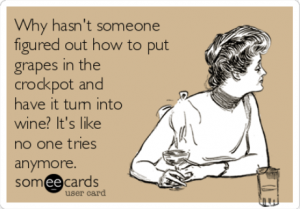 With our litany of complaints out of the way, we can now turn to the positive aspects – namely the wine itself and the pleasure it can bring us all. Rosé wines are made using a number of different techniques and its name (French for pink) encompasses all wines falling between red and white on the color spectrum. The method that typically produces the highest quality rosé is maceration, in which the juice of red grapes “sits” on its peel for a short period of time (typically a few hours to a few days) and then the skins are discarded. Remember, with only a few exceptions, all grape juice is white, gaining its color from maceration on the darker-colored grape skins. Generally speaking, the longer the contact with the skins the darker in color and the more full-bodied and tannic the resulting wine will be. The limited amount of skin contact ensures that rosé wines are very low in tannins, a crucial factor in their ability to be consumed über-cold. Unfortunately, the shorter maceration time also yields a less stable wine, with a short shelf life and much more susceptible to oxygenation wine – one of the primary reason one should only drink rosé within the one year period of vintage). With respect to grape varietals, rosé can be and is made from almost any red grape including Cabernet Sauvignon, Merlot, Cabernet Franc, Barbera, Carignan, Syrah, Sangiovese, Zinfandel, Tempranillo, Grenache and Mourvèdre in addition to blends of these and other grapes, with a preference to grapes that are naturally higher in acidity.
With our litany of complaints out of the way, we can now turn to the positive aspects – namely the wine itself and the pleasure it can bring us all. Rosé wines are made using a number of different techniques and its name (French for pink) encompasses all wines falling between red and white on the color spectrum. The method that typically produces the highest quality rosé is maceration, in which the juice of red grapes “sits” on its peel for a short period of time (typically a few hours to a few days) and then the skins are discarded. Remember, with only a few exceptions, all grape juice is white, gaining its color from maceration on the darker-colored grape skins. Generally speaking, the longer the contact with the skins the darker in color and the more full-bodied and tannic the resulting wine will be. The limited amount of skin contact ensures that rosé wines are very low in tannins, a crucial factor in their ability to be consumed über-cold. Unfortunately, the shorter maceration time also yields a less stable wine, with a short shelf life and much more susceptible to oxygenation wine – one of the primary reason one should only drink rosé within the one year period of vintage). With respect to grape varietals, rosé can be and is made from almost any red grape including Cabernet Sauvignon, Merlot, Cabernet Franc, Barbera, Carignan, Syrah, Sangiovese, Zinfandel, Tempranillo, Grenache and Mourvèdre in addition to blends of these and other grapes, with a preference to grapes that are naturally higher in acidity.
Another common rosé-making method is the Saignée method (French for “bleed”) in which rosé is simply a byproduct of red wine production. Some of the red wine is drained out of the vats prior to fermentation and set aside for rosé production. A common reason for doing this is when a wine maker wants to increase the intensity of a red wine they are producing. By draining some of the pink juice prior to fermentation, the resulting wine will be highly concentrated which usually equals a more intensely flavored wine. The drained pink juice is fermented separately and results in rosé. Historically the method that produced the greatest number of rosé, as rosé production has started to receive the recognition it deserves (not only due to the hefty profit margins it can provide), it has recently started taking a backseat to the first method which can produce wines of a higher quality.
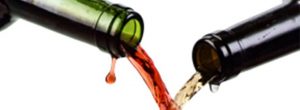 Another, far less common and barely worth even mentioning, production method is blending red and white wines. Other than with respect to the cheapest and most commercialized of wines, this methodology is primarily used to make Champagne, where Pinot Noir is added to a Chardonnay base to create the sexiest of all wines – rosé Champagne (or its non-Champagne equivalent – rosé sparkling wine). While exceptionally rare, the maceration method is sometimes used to create rosé sparkling wine by allowing Pinot Noir grapes very brief skin contact during fermentation and avoiding the need to blend them with Chardonnay.
Another, far less common and barely worth even mentioning, production method is blending red and white wines. Other than with respect to the cheapest and most commercialized of wines, this methodology is primarily used to make Champagne, where Pinot Noir is added to a Chardonnay base to create the sexiest of all wines – rosé Champagne (or its non-Champagne equivalent – rosé sparkling wine). While exceptionally rare, the maceration method is sometimes used to create rosé sparkling wine by allowing Pinot Noir grapes very brief skin contact during fermentation and avoiding the need to blend them with Chardonnay.
The genre’s popularity growth has somewhat reduced the prevalence of another “type” of Rosé – blush wine or “White [X]”, with the [X] substituted with whichever grape the wine in question is produced (a phenomenon mostly confined to the US market). One unfortunate example would be “White Zinfandel” that, for some unfathomable reason, tends to be a pretty popular wine (despite it being a beverage you should never, ever drink). If there were ever a wine that could compete with the Blue Bottled Abomination for my oenophilic disdain – White Zinfandel would be it. Besides the general inferior quality of nearly every manifestation, almost every kosher version of this poor excuse for a wine bears partial responsibility for kosher wine’s poor reputation among many (albeit ill-informed) individuals.
The Pleasures of Pink
Among rosé’s many charms is how delightfully refreshing the wine can be when served well chilled. While there are plenty of serious rosé wines out there with depth and complexity, even those can be simply enjoyed without too much thought in the event the mood strikes you. As with any other beverage, some of the aromatics are muted when served overly chilled, but I still prefer to serve rosé at about 46-50ºF (8-10ºC) –slightly colder than its optimum drinking temperature. This allows the wine to gradually come to the right temperature in your glass so it can be enjoyed properly, as opposed to starting out at the right temperature and rapidly becoming warm and insipid before you get past your first sip (especially given the frequency in which rosé is enjoyed outdoors in the summer heat). Rosé is the quintessential picnic or breakfast wine, matching beautifully with omelets, fried and lightly grilled fish and much of the lighter fare we tend to start reaching for as the mercury skyrockets. One of rosé’s magical attributes is the versatility it brings to nearly every table and, in addition to the lighter fare, I often find myself reaching for a slightly more robust rosé to pair with grilled and barbequed meats being served outdoors. The tannic background and heft stand up nicely to most such heavier dishes while provided the needed cutting acidity and crisply refreshing relief so appreciated under the hot summer sun.
The majority of rosé wines contain a varying touch of residual sugar, sometimes exacerbated by the perceived sweetness from their characteristic notes of rich summer fruit. My personal preference is for exceedingly dry and crisp rosé wines; a genre of rosé that historically has provided slim pickings for the kosher wine consumer, especially for those who enjoy Israeli wines (likely resulting from the Israeli wine-drinking public’s preference for sweet). Many options contain a bit of residual sugar, and there are also many dry versions available as well (and there is nothing wrong with a bit of well-balanced residual sugar, especially in a delicious summer quaffer).
Some Like it Hot
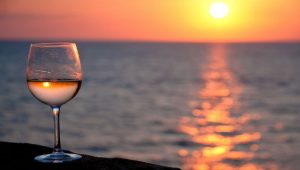 Whenever possible, I taste wines over a long period of time (18-36 hours), with varying amounts of air (pop & pour, aerators, decanting) and at different temperatures (38º (refrigerator) -55º (cellar) – 70º (room)). I do this for the same reason that I try and purchase every wine from a retailer before I release a tasting note – to ensure that my experience / tasting notes resembles, reflects as closely as possible, the circumstances under which my readers will experience the wine. While not the optimal temperature, its position as fun, guilt-free, summer dictates that the vast majority of rosé to be popped and poured directly from the refrigerator they were chilling in at the icy temperature of 38ºF (~3.5ºC). As such, a fair number of options didn’t make the list since they required much more care and handling then I expect they will get. Some wines were only able to reveal their charms after excessive airtime (24-36 hours), while others required temperatures in excess of 60º before they provided sufficient pleasure to be considered for this list; both conditions unlikely to be afforded most of the rosé consumed this summer.
Whenever possible, I taste wines over a long period of time (18-36 hours), with varying amounts of air (pop & pour, aerators, decanting) and at different temperatures (38º (refrigerator) -55º (cellar) – 70º (room)). I do this for the same reason that I try and purchase every wine from a retailer before I release a tasting note – to ensure that my experience / tasting notes resembles, reflects as closely as possible, the circumstances under which my readers will experience the wine. While not the optimal temperature, its position as fun, guilt-free, summer dictates that the vast majority of rosé to be popped and poured directly from the refrigerator they were chilling in at the icy temperature of 38ºF (~3.5ºC). As such, a fair number of options didn’t make the list since they required much more care and handling then I expect they will get. Some wines were only able to reveal their charms after excessive airtime (24-36 hours), while others required temperatures in excess of 60º before they provided sufficient pleasure to be considered for this list; both conditions unlikely to be afforded most of the rosé consumed this summer.
Similar to the mixed bag which was the 2016 vintage, 2017 once again is, once again showcasing wildly disparate quality levels without discriminating between traditionally top tier producers and those whose offerings usually sit lower on the totem pole. While you all know that winemaking skill is a major factor in separating the men from the proverbial boys (along with quality terroir and skillful vineyard maintenance), I was unpleasantly surprised at some poor showings from a number of top tier producers, including those who have had great success with rosé over the last few years (needless to say, none of those wines are included below). We can all only collectively hope and pray that the 2018 will prove the last few years to be an anomaly as we return to consistent quality increases across the board.
I have included tasting notes for the 20 rosé wines I most enjoyed from the 2017 vintage. Given that rosé is a wine built as one of life’s simple pleasures, I have used abbreviated tasting notes for this week’s newsletter. While the list below doesn’t include every good option from the 93 wines I tasted, it does include a few options for every type of rosé we have discussed. Trying to ensure you won’t have to seek wines outside the list, I made sure to cover the entire spectrum so whether you are in the market for bone-dry rosé or wines with a touch (or more) of perceived (or actual) sweetness; a lithe, light-bodied, pale and subtle wine or a more robust and exuberant options, the list below will have something for from the entry-level pricing of around $12 all the way up the chain to the higher-end options that are clocking in at $35-40 (I didn’t find the few over $50 options worthy of your attention – a decision made, as always, regardless of price). Sticking to the list means you don’t have to stray outside it but should you so desire, feel free to email with any specific questions about any wine not on the list (or otherwise).
Most importantly, remember that rosé is not a wine to be taken seriously – they are meant to be fun – so chill (pun intended), relax and enjoy!
Adir, Barbera, Rosé, 2017: 100% Barbera, bitter, refreshing and pleasing (although it was one of the rare rosé wines I enjoyed significantly more in its country of origin (Israel) than post-importation into the US). Tart red fruit, a hint of summer fruits, and a light to medium bodied palate with good acidity. The US imported bottle showed a little flatter with less complexity than the bottles I enjoyed in Israel.
Carmel, Appellation, Rosé, 2017: A blend of Grenache and Tempranillo from the winery’s Judean Hills’ vineyards. Abundant rich and exuberant sweet fruit including tart cherries, pineapple, stone fruit and raspberries along with some flinty minerals and luscious lemon. Medium bodied with a slightly viscous palate. Slightly sweet, but well balanced by the acidity and minerals and enjoyable.
Château Roubine, La Vie, Cotes du Provence, Rosé, 2017: A blend of Grenache, Cinsault and Syrah. As opposed to last year, this year’s La Vie was better made than the “regular” Roubine this year. A little sweeter than I like my rosé but well balanced with sufficient acidity and tart red fruit, along with Meyer lemon, white grapefruit and clementines with warm spices, that it will be enjoyed by many.
Château Saint Beatrice, Instant B, Rosé, Provence, 2017: Owned by the proprietors of Château Roubine, I preferred this lower-priced (and mevushal) option over both its more expensive brethren. A blend of the same three grapes (Grenache, Cinsault and Syrah), the wine is exceptionally well made with great balance between the subtle Provence-style fruit, bracing acidity and flint minerals. A lovely summer quaffer with a great price point that will enable you to enjoy it early and often [mevushal].
Covenant Israel, Blue C, Rosé, 2017: Using the saignée method to bleed some juice from the winery’s high-end Tel-Phares Syrah, the wine opens with a pretty aggressive herbal nose that needs a few minutes of air before it reveals the lovely sweet red fruits including watermelon and cherries, red grapefruit and rosewater along with a subtle hint of white flowers. Once the wine relaxes a bit, it provides lovely summer pleasure with good acidity and a whiff of pleasing bitter complexity.
Dalton, Estate (Canaan in Israel), Rosé, 2017: Representing quality winemaking and being imminently approachable every year has earned the wine a near permanent spot on this list and this year’s version really hit it out of the park. Showcasing Dalton’s characteristic minimalistic style, the wine is well balanced with enough RS to please nearly every palate while providing great balancing acidity and a lovely array of wild red summer fruit, some light tropical notes, citrus and very subtle herbal notes that keep things lively. At a price point that encourages one to consume this all summer long, I doff my head and simply say kudos and thank you.
Flam, Rosé, 2017: After slightly missing a step with the 2016 vintage, I was very happy to find flam back in form with this delightful offering. A blend of Merlot, Cabernet Sauvignon, Cabernet Franc and Syrah, all harvested early from plots pre-designated for the wine and co-fermented in whole-clusters for added depth and complexity. The earlier harvest certainly made its positive mark, yielding a nuanced and complex wine with subtle fresh fruit flavors (more subtle than usual), lemon and orange citrus notes backed up with pleasing slate minerals, fresh-picked flowers and a whiff of bitter herbs. Bracing acidity keeps things lively and if it weren’t for the over $30 price tag, I’d be drinking this one all summer long.
Hagafen, Don Ernesto, Rosé, 2017: Utilizing Hagafen’s Syrah grapes and the saignée method provided Hagafen with a follow up success to last year’s delicious wine. With a very rich and aromatic nose, the wine is loaded with cherries and strawberries along with crushed rose petals, red grapefruit, citrus pith, light herbal notes and pleasing bitterness backed by ample acidity in great balance with the rich fruit. Medium bodied and definitely on the sweet side (but very well balanced), the robust body makes it a food-pairing wine more than an all-day quaffer [Mevushal / only in the US; Direct from the Winery].
Hajdu, Rosé, 2017: 13.5% AbV. A blend of Sangiovese, Barbera and Grenache, John was clearly focused on ensuring sufficient acidity to back up his usual slate of robust and rich red fruits and it worked. The fruit is all there but more subtle than past years and well balanced with the abundant acidity, slate, citrus pith and biting minerals with provide lingering pleasure. Medium bodied with a bit more heft than your typical rosé [Only in the US].
Jezreel Valley, Rosé, 2017: One of the rare rosé wines comprised of red and white grapes, the wine is a blend of Syrah (40%), Carignan (45%) and Sauvignon Blanc (15%). Very refreshing with balancing acidity, a rich fruity nose with a more subtle palate of cherries, watermelon, pomegranate, strawberries; nicely complimented by bitter herbaceousness adding some welcome complexity. Big and juicy, the wine will please everyone but the most hard core, acid-crazed, rosé wine lovers for whom any perception of sweet red fruit is a cardinal sin.
Kishor, Kerem Kishor, Rosé, 2017: Picked early from grapes specially allocated to make rosé, a blend of Cabernet Franc and Grenache fermented in neutral oak barrels. Bright, fresh notes of range citrus, sun-kissed Mediterranean herbs and summer fruits, the wine’s balancing acidity and biting minerals makes it a great summer quaffer while the winery’s personal story (similar to tulip, the winery provides employment for adults with special needs) makes it an easy buy [Only in Israel].
Netofa, Domaine Netofa, Rosé, 2017: One of my favorite options this year with a price that provides especially high QPR, making it even sadder than Netofa wines are still not imported into the US (I enjoyed it far more than the higher-end Latour Rosado). A blend of Syrah, Grenache and Mourvedré, the wine is loaded with warm spices, roasted herbs and minerals provided nuanced complexity to the subtle red fruit (along with an intriguingly pleasing streak of salinity), the wine’s medium bodied and slightly viscous palate provide robust contra to most summer meals, including grilled meats. Stock up and enjoy all summer long and then some [Only in Israel].
Or HaGanuz, Amuka, Rosé, 2017: Another lovely option I found too sweet for my personal tastes but sufficiently balanced and refreshing to be recommendable, as only the acid-craving anti-(perception of) sweet rosé-style wine lovers won’t like this wine. Blended from equal parts Cabernet Franc, Merlot, Shiraz and Mourvedré, the wine showcases sweet red fruit and tropical notes of pineapple and guava, with a lovely overlay of herbal notes, slightly bitter and pleasing citrus pith and rose petals backed by bracing acidity around a lovely tannic core that provides welcome heft but makes it more of a mealtime wine than an all-day thirst-quencher.
Psagot, Rosé, 2017: Salmon colored with lush cherry, strawberries, red grapefruit, candied cranberries and rosewater enhanced by slate minerals and backed by sufficient lip-smacking acidity. Well made and somewhat contemplative, another great option from Psagot where Yaacov Oryah’s hand is definitely showing.
Ramon Cordova, Rosado, 2017: Another combination of red (80% Grenache) and white (20% Macabeo (a/k/a Viura)) grapes helped the wine make the list for the second year in a row (easily the most interesting kosher wine produced from this winery to date). 13.5% AbV and light bodied make for a refreshing thirst-quencher with remarkably pale color and ever-so-subtle (barely noticeable) fruit backed with sufficient acidity to whet your appetite for whatever summer treats will hit your table next.
Recanati, Gris de Marselan, Rosé, 2017: A subtle and complex nose that slowly reveals itself over the few minutes it will have in your glass before it’s consumed. Floral notes of white flowers and lavender provide nuance to the crushed strawberries, stone fruit and luscious red grapefruit and other citrus notes all in near-perfect balance and harmony. Good balancing acidity ensures the wine will provide great food pairing to almost anything your summer cooking will throw at it. Recanati’s entry-level option was also good, but sufficiently unbalanced to knock it out of contention for this list [Only in Israel].
Shirah, Rosé, 2017: A truly delightful and refreshing wine, this year a blend of Grenache and Nebbiolo (with a touch of Zinfandel providing some extra oomph) and one of my favorite options. Open, approachable with a tad of perceived sweetness from the abundant and rich red fruit, the wine is sure to be a house favorite every you go while standing up nicely to nearly anything you’d want to consume during the long hot summer days and nights. With earthy minerals, a hint of tannin and plenty of citrus providing well-balanced contra to the red and summer fruits all being backed up by gobs of refreshing acidity, this is a wine to load up on and enjoy constantly [Only in the US].
Tabor, Adama, Barbera, Rosé, 2017: Similar to the Dalton, this is a great, affordable entry-level rosé with plenty of sweet red strawberries, tart cherry and hints of cranberries backed up by grapefruit, lemon and citrus pith but a hint of herbs. Good balancing acidity keeps things refreshing. Well made and balanced, a great summer quaffer.
Teperberg, Impression, Rosé, 2017: A blend of Grenache and Barbera with good acid and nice minerals balancing out the strawberry, cherry, white peaches, cranberries and red citrus notes. A lovely herbal nuance gives the wine some depth and makes it slightly more interesting [Mevushal].
Vitkin, Israel Journey, Pink, Rosé, 2017: A robust blend of Grenache and Carignan with a lovely and aromatic nose and a medium bodied palate, all loaded to bear with juicy sun-kissed strawberries, red grapefruit, rosehip, nuanced tropical fruit including sweet pineapple, guava and some quince all backed by judicious balancing acidity that helps negate the sweet fruit and make for an extremely pleasurable drinking experience. Kudos to Asaf.